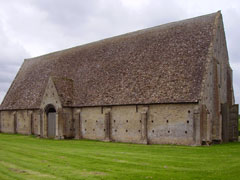




Back to the Intro Page







People still worked in fields and grew their own food. Peasants had to give 10% of everything they grew to the local church. This was called a tithe and would be stored in a tithe barn. You might have heard the word. Some tithe barns still exist today. Farmers used a 3 field system so that they did not grow the same crops in each field every year. Peasants would graze their animals near their houses but, in autumn, some lords, the nice ones, would let their peasants run their pigs through the woods to fatten them up for the winter; the pigs not the peasants, they would never get fat. Craftsmen were getting better organised and joined guilds. The guild would set prices and also weights and measures. It would cost master craftsmen to belong to a guild and with the money they made the guilds would do things for the local community. A guild was really like a business club. Ordinary people could still come and sell their goods at market but they had to pay a tax for setting up a stall. Streets in towns might be named after the trades that worked there. Tanner Lane could be where tanners worked (they made leather), Coopers Road where coopers worked (they made barrels) and Pudding Lane (to become famous in Stuart times) where bakers would be. The working day was still governed by daylight as very few people used candles and candle light wasn't that bright.
Back to the Plantagenets Hoots - Daily LifeForward to the Houses of Lancaster and York Hoots - Daily Life

